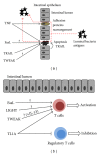Tumour necrosis factor superfamily members in the pathogenesis of inflammatory bowel disease
- PMID: 25045210
- PMCID: PMC4087264
- DOI: 10.1155/2014/325129
Tumour necrosis factor superfamily members in the pathogenesis of inflammatory bowel disease
Abstract
Inflammatory bowel disease (IBD) is a group of inflammatory conditions of the gastrointestinal tract of unclear aetiology of which two major forms are Crohn's disease (CD) and ulcerative colitis (UC). CD and UC are immunologically distinct, although they both result from hyperactivation of proinflammatory pathways in intestines and disruption of intestinal epithelial barrier. Members of the tumour necrosis factor superfamily (TNFSF) are molecules of broad spectrum of activity, including direct disruption of intestinal epithelial barrier integrity and costimulation of proinflammatory functions of lymphocytes. Tumour necrosis factor (TNF) has a well-established pathological role in IBD which also serves as a target in IBD treatment. In this review we discuss the role of TNF and other TNFSF members, notably, TL1A, FasL, LIGHT, TRAIL, and TWEAK, in the pathogenesis of IBD.
Figures

References
Publication types
MeSH terms
Substances
LinkOut - more resources
Full Text Sources
Other Literature Sources
Medical

